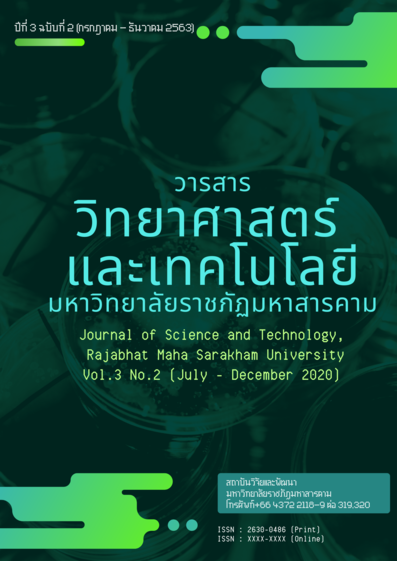Effect of Riceberry Flour on Qualities of Muffin Gluten Free
Keywords:
Muffin, Rice Berry flour, Free GlutenAbstract
The objective is study and develop the appropriate formula muffins riceberry. The acceptance of the products, formulations, compare chemistry, consumer acceptance of the muffins wheat flour and muffins riceberry.
The results showed that the chemical composition of riceberry flour include moisture content, protein and fat is lower than wheat flour. But ash, fiber, reducing sugar and total Phenolic content is higher value than wheat flour. Muffin riceberry, adapted from basic formula is chemistry and total Phenolic content of muffin product that moisture content, ash, protein, fat, fiber and total Phenolic content is 11.53% 8.32% 1.45% 1.95% and 1.49% respectively. Preference test of the product formula muffins riceberry is a liking color, odor, flavor and overall in the low. The hardness, sticky and bitterness is quietly. Sweet and crispness in the least favorite. Consumer acceptance of the muffin formular Riceberry appropriate is color, odor and crispness in just liking. The flavor and overall is in low.
References
กนกวรรณ ตุ้นสกุล. (2549). การพัฒนาผลิตภัณฑ์มัฟฟินที่มีคุณค่าทางโภชนาการสำหรับอาหารเช้าจากแป้งข้าวกล้องหอมมะลิ. สาขาวิชาพัฒนาผลิตภัณฑ์อุตสาหกรรม ภาควิชาพัฒนาผลิตภัณฑ์.
จุฑารัตน์ ฮั่นบุญศรี, และลัดดาวัลย์ เชื้อเจริญ. (2546). การพัฒนาผลิตภัณฑ์มัฟฟินเจ. ปริญญานิพนธ์. ภาควิชาอุตสาหกรรมเกษตร สถาบันเทคโนโลยีพระจอมเกล้าเจ้าคุณทหารลาดกระบัง.
ธีรนุช ฉายศิริโชติ, และ จันทร์จนา ศิริพันธ์วัฒนา. (2557). การพัฒนามัฟฟินเนื้อตาลสุกผสมลูกตาล. วารสาร มสด สาขาวิทยาศาสตร์และเทคโนโลยี. 7 (1) มกราคม-เมษายน, 57-70.
ปัจจยา ตันตีวีรสุต, ณัฏฐา เลาหกุลจิตต์, อุทัยวรรณ สุททธิศันสนีย์, ฉัตรภา หัตถโกศล, และ พร้อมลักษณ์ สมบูรณ์ปัญญากุล. (2557). ผลของการใช้แป้งข้าวไรซ์เบอรี่พรีเจลาทิไนซ์เพื่อลดไขมันในน้ำสลัด. วารสารวิทยาศาสตร์เกษตร. 45 (2) (พิเศษ),125-128.
ปัศนีย์ มาเยอ, จินตนา สมวงค์ทวีชัย, อุบลรัตน์ พรหมฟัง, และจิรภา พงษ์จันตา. (มปป.). การพัฒนาสูตรผลิตภัณฑ์มัฟฟินที่มีค่าดัชนีน้ำตาลต่ำเส้นใยสูง. นเรศวรวิจัย ครั้งที่ 12: วิจัยและนวัตกรรมกับการพัฒนาประเทศ. 290-298.
วนิดา มะยมทอง. (2546). การใช้แป้งมันสำปะหลังพันธุ์หวาน ทดแทนแป้งสาลีในผลิตภัณฑ์มัฟฟิน. มหาวิทยาลัยเกษตรศาสตร์. กรุงเทพฯ.
อภิญญา เจริญกูล. (2547). ผลของผงฟูและไข่ต่อคุณภาพของมัฟฟินแป้งข้าวกล้องงอก. วารสารวิทยาศาสตร์เกษตร. 43 (2), 373-376.
AOAC International (2000). Official Methods of Association of official Agriculture Chemist. 17th Ed., Gaithersburg, MD, USA.
Hussein, M.A, Saleh, & Noaman, M. (1976). Nutritional and rheological properties of sorghum. M.Sc. thesis University of Mansoura, Egypt.
Murray, J. A. (1999). The widening spectrum of celiac disease. American Journal of
Clinical Nutrition 69, 354–365.
Ohtsubo, K., Suzuki, K., Yasui, Y., & Kasumi, T. (2005). Bio-functional components in the processed pre-germinated brown rice by a twin- screw extruder. Journal of food composition and analysis. 18, 303–316.
Sharma, P., Gujral, S.H., & Singh, B. (2012). Antioxidant activity of barley as affected by extrusion cooking. Food chemistry. 131 (4), 1406-1413.
Singleton, V.L., Orthofer, R., & Lamuela-Raventos, R.M. 1999. Analysis of total phenols and other oxidation substrates and antioxidants by means of folin-ciocalteu reagent. Methods and Enzymology. 299, 152-178.
Supatchalee, S., Juthamat, P., & Anuntachai K. (2015). Effect of Partial Substitution of Wheat Flour with Riceberry Flour on Quality of Noodles.
Wanvijit, A. (2008). The Integrated Biotechnology Project in creating Strains of rice for Value Added and Rich in Nutrition. (Research Report). Kasetsart University and Mahidol University. Bangkok.
Zielinski, H., Kozlowska, H., & Lewczuk, B. (2001). Bioactive compounds in the cereal grains before and after hydrothermal processing. Innovative Food Science and Emerging Technology. 2, 159–169.



